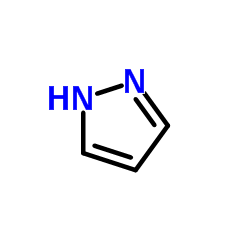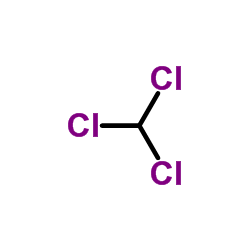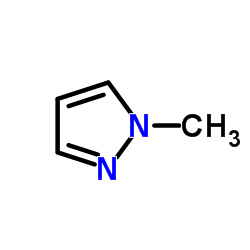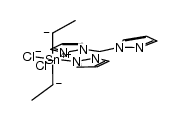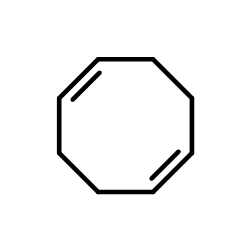80510-03-8
| Name | 1-[di(pyrazol-1-yl)methyl]pyrazole |
|---|---|
| Synonyms | MFCD00040255 |
| Density | 1.38g/cm3 |
|---|---|
| Boiling Point | 399.6ºC at 760 mmHg |
| Melting Point | 103-104ºC |
| Molecular Formula | C10H10N6 |
| Molecular Weight | 214.22700 |
| Flash Point | 195.5ºC |
| Exact Mass | 214.09700 |
| PSA | 53.46000 |
| LogP | 0.82880 |
| Index of Refraction | 1.734 |
|
Section 1: Product Identification Chemical Name:Tris(pyrazol-1-yl)methane, min. 98% CAS Registry Number:80510-03-8 Formula:C10H10N6 EINECS Number:none Chemical Family:organic amine Synonym:none
Section 2: Composition and Information on Ingredients IngredientCAS NumberPercentACGIH (TWA)OSHA (PEL) Title compound80510-03-8100%no datano data Section 3: Hazards Identification Emergency Overview:No particular hazard associated with this material. Primary Routes of Exposure:Ingestion, inhalation Eye Contact:May cause slight to mild irritation of the eyes Skin Contact:May cause slight to mild irritation of the skin. Inhalation:The material is a fine powder. Irritating to the nose, mucous membranes and respiratory tract. Ingestion:No specific information is available on the physiological effects of ingestion. Acute Health Affects:May be irritating to skin, eyes and respiratory tract. Chronic Health Affects:No information available on long-term chronic effects. NTP:No IARC:No OSHA:No SECTION 4: First Aid Measures Immediately flush the eyes with copious amounts of water for at least 10-15 minutes. A victim may need Eye Exposure: assistance in keeping their eye lids open. Get immediate medical attention. Wash the affected area with water. Remove contaminated clothes if necessary. Seek medical assistance if Skin Exposure: irritation persists. Remove the victim to fresh air. Closely monitor the victim for signs of respiratory problems, such as difficulty Inhalation: in breathing, coughing, wheezing, or pain. In such cases seek immediate medical assistance. Seek medical attention immediately. Keep the victim calm. Give the victim water (only if conscious). Induce Ingestion: vomiting only if directed by medical personnel. SECTION 5: Fire Fighting Measures Flash Point:no data Autoignition Temperature:none Explosion Limits:none Extinguishing Medium:carbon dioxide, dry powder or foam If this material is involved in a fire, fire fighters should be equipped with a NIOSH approved positive pressure Special Fire Fighting Procedures: self-contained breathing apparatus and full protective clothing. Hazardous Combustion andIf involved in a fire this material may emit toxic organic fumes. Decomposion Products: Unusual Fire or Explosion Hazards: No unusual fire or explosion hazards. SECTION 6: Accidental Release Measures Spill and Leak Procedures:Small spills can be mixed with vermiculite or sodium carbonate and swept up. SECTION 7: Handling and Storage Handling and Storage:Store in a tightly sealed container. Keep away from heat and moisture. SECTION 8: Exposure Controls and Personal Protection Eye Protection:Always wear approved safety glasses when handling a chemical substance in the laboratory. Skin Protection:Wear protective clothing and gloves. Ventilation:If possible, handle the material in an efficient fume hood. If ventilation is not available a respirator should be worn. The use of respirators requires a Respirator Respirator: Protection Program to be in compliance with 29 CFR 1910.134. Ventilation:If possible, handle the material in an efficient fume hood. Additional Protection:No additional protection required. SECTION 9: Physical and Chemical Properties Color and Form:white pwdr. Molecular Weight:214.23 Melting Point:103-104° Boiling Point:no data Vapor Pressure:no data Specific Gravity:no data Odor:no data Solubility in Water:no data SECTION 10: Stability and Reactivity Stability:air and moisture-stable solid Hazardous Polymerization:none Conditions to Avoid:none Incompatibility:strong oxidizing agents Decomposition Products:carbon dioxide, carbon monoxide, organic fumes, and nitrogen dioxide SECTION 11: Toxicological Information RTECS Data:No information available in the RTECS files. Carcinogenic Effects:No data available Mutagenic Effects:No data available Tetratogenic Effects:No data available SECTION 12: Ecological Information Ecological Information:No information available SECTION 13: Disposal Considerations Disposal:Dispose of according to local, state and federal regulations. SECTION 14: Transportation Shipping Name (CFR):Non-hazardous Hazard Class (CFR):NA Additional Hazard Class (CFR):NA Packaging Group (CFR):NA UN ID Number (CFR):NA Shipping Name (IATA):Non-hazardous Hazard Class (IATA):NA Additional Hazard Class (IATA):NA Packaging Group (IATA):NA UN ID Number (IATA):NA SECTION 15: Regulatory Information TSCA:Not listed in the TSCA inventory. SARA (Title 313):Not reportable under SARA Title 313 Second Ingredient:none SECTION 16 - ADDITIONAL INFORMATION N/A |
| HS Code | 2933199090 |
|---|
|
~78% 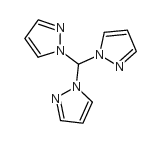
80510-03-8 |
| Literature: Shakirova; Lavrenova; Kurat'eva; Naumov; Daletskii; Sheludyakova; Logvinenko; Vasilevskii Russian Journal of Coordination Chemistry/Koordinatsionnaya Khimiya, 2010 , vol. 36, # 4 p. 275 - 283 |
|
~30% 
80510-03-8 |
| Literature: Perez, Jorge D.; Yranzo, Gloria I.; Ferraris, Marisa A.; Claramunt, Rosa M.; Lopez, Concepcion; Elguero, Jose Tetrahedron, 1988 , vol. 44, # 20 p. 6429 - 6434 |
|
~% 
80510-03-8 |
| Literature: Byers, Peter K.; Canty, Allan J.; Honeyman, Thomas Journal of Organometallic Chemistry, 1990 , vol. 385, # 3 p. 417 - 427 |
|
~% 
80510-03-8 |
| Literature: Hueckel; Bretschneider Chemische Berichte, 1937 , vol. 70, p. 2024 |
|
~% 
80510-03-8 |
| Literature: Visalakshi, R.; Jain, V. K.; Kulshreshtha, S. K.; Rao, G. S. Inorganica Chimica Acta, 1986 , vol. 118, p. 119 - 124 |
| Precursor 5 | |
|---|---|
| DownStream 3 | |
| HS Code | 2933199090 |
|---|---|
| Summary | 2933199090. other compounds containing an unfused pyrazole ring (whether or not hydrogenated) in the structure. VAT:17.0%. Tax rebate rate:13.0%. . MFN tariff:6.5%. General tariff:20.0% |
